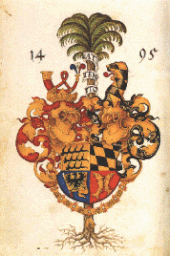Oberrat (Duchy of Württemberg)
The Oberrat in Duchy Württemberg was, after the establishment of the Duchy, 1495-1662 the central administrative body and the top government agency in Württemberg . After the rent chamber and the church council had been separated from the administrative authority, he was permanently replaced in his function as the highest government body by the secret council in 1662 .
history

The administrative development of Württemberg received a strict structure through the Habsburg rule. The county of Württemberg was elevated to a duchy on July 21, 1495 . The first state ordinance put Duke Eberhard I (1445–1496) into force in 1495 ; it became the actual basis for the emergence of the upper council, whose basic structure was the ducal chancellery , the rent chamber and the church council, the "three central authorities ". Until 1520 the administration was headed by a country steward, next to them a chancellor, two tax officials, the chamber clerk as the treasurer and the land clerk as the computer. From 1498 to the beginning of Christoph's rule (1515–1568) in 1550, the duchy was shaken by internal disputes and armed conflicts, only with him did a calmer and continuous reign begin. According to a provisional order from 1550, Christoph had established the final administrative structure with his chancellery order from 1553 and completed the reorganization of the administration. He now ensured the continuity of government structures and issued new rules and laws , noteworthy was the “ Great Church Ordinance ” of 1559. According to the Chancellery Ordinance of 1553, the Upper Council now consisted of the Landhofmeister with Chancellor as well as noble and civil councilors. The Landhofmeister presided over the upper council, the office was now independent and the financial administration was led by the land clerk. Wuerttemberg was groundbreaking with the establishment of the visitation , which included both the ecclesiastical as well as the secular officials .
Tasks of the ducal high council
With the new government structure, the Upper Council became the highest government authority, it was the highest supervisory authority over all other authorities and also had its own responsibilities . He was the highest judicial authority in legal disputes between the duke and high government officials, municipalities or corporations and led witch trials in the duchy between 1497 and 1750 . His responsibilities ranged from questions of sovereign, domestic, judicial and police administration to the regulation of all diplomatic , foreign and military matters. Due to the Duke's patronage over the Zwiefalten Monastery , the Oberrat was also responsible for exercising the Württemberg rights vis-à-vis Zwiefalten Monastery within the scope of its jurisdiction.
Neutralization of the upper council
Christoph's later successor Friedrich I (1557–1608) placed his emphasis on the privileges of respectability during his reign and wanted to strengthen the position of the nobility , which resulted in the rule of an absolute prince. His reign from 1593–1608 was guided by purposeful action, showed autocratic tendencies and involved elaborate court keeping. The councils were de facto switched off and any resistance threatened with dismissal or dissolution.
End of the upper council as the highest government authority
In the course of the guardianship for the underage son Johann Friedrichs († 1626), Duke Eberhard III. (1614–1674), who were taken over by Ludwig Friedrich (1586–1586) from 1628 to 1630 and from 1630 to 1633 by Julius Friedrich (1588–1635) together with Barbara Sophia von Brandenburg (1584–1636), held a college of privy councils , as a kind of Regency Council , the superintendent of the Oberrat. As Eberhard III. In 1633, when he came of age, “under pressure from the estates, the secret council remained in place and committed to both the duke and the estates. After the turmoil of the Thirty Years' War , the chancellery regulation of 1660 stipulated that the Secret Council was now only obliged to the Duke. The secret council included the court master, the chancellor and three other heads of the central authorities. Of these five councils, three were usually from the nobility and two from the bourgeoisie . Since then, the upper council, rent chamber and church council (consistory) have been subordinate to the secret council ”.
literature
- Alois Marquart: The former ducal, later electoral old Württemberg government college in Stuttgart and Ludwigsburg . In: Württembergische Vierteljahreshefte für Landesgeschichte 15 (1906). s. 127-146.
- Friedrich Wintterlin: History of the organization of authorities in Württemberg . Volume 1. Stuttgart 1904.
- B. Wunder, The Swabian Circle. In: Jeserich, Verwaltungsgeschichte 1 (1983), pp. 615–633.
Web links
- Baden-Württemberg State Archive - Stuttgart Capital Archive: Thomas Fritz, Authority History , Stuttgart 2014
- books.google.de Google Books Meinrad Schaab , Hansmartin Schwarzmaier (Eds.) u. a .: Handbook of Baden-Württemberg History . Volume 1: General History. Part 2: From the late Middle Ages to the end of the old empire. Edited on behalf of the Commission for Historical Regional Studies in Baden-Württemberg . Klett-Cotta, Stuttgart 2000, ISBN 3-608-91948-1 .
- History of the Duchy of Württemberg from 1495 to 1803
- County and Duchy of Württemberg . Discover regional studies online (leobw)
Individual evidence
- ↑ Chamber scribe . In: Former Academy of Sciences of the GDR, Heidelberg Academy of Sciences (Hrsg.): German legal dictionary . tape 6 , issue 7 (edited by Hans Blesken, Siegfried Reicke ). Hermann Böhlaus successor, Weimar 1967, OCLC 833208342 ( adw.uni-heidelberg.de ). Servant at a princely court for office work, accounting or administration.
- ↑ Files of the church leadership before 1924 (Landeskirchliche Archiv Stuttgart) archiv.elk-wue.de
- ↑ On jurisdiction: Hannes Weik, Hexenwerk oder Gottes Zorn? Witch persecution in southwest Germany in the context of the "Little Ice Age" (1560–1630). Diplomica Verlag , Hamburg 2013, ISBN 3-8428-8889-9 , p. 57 ff., Books.google.de
- ^ Peasants' War and Reformation in Württemberg geschichtsverein-koengen.de
- ↑ Compare Privy Council (Württemberg)